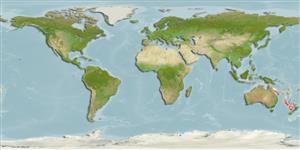>
Acropomatiformes (Oceanic basses) >
Malakichthyidae (Temperate ocean-basses)
Etymology: Malakichthys: Greek, malakia = softness + Greek, ichthys = fish (Ref. 45335); mochizuki: Named for Kenji Mochizuki (CBM).
Eponymy: Kenji Mochizuki researched (1980s) at the Department of Fisheries, University Museum, University of Tokyo. [...] (Ref. 128868), visit book page.
Environment: milieu / climate zone / depth range / distribution range
Écologie
marin bathypélagique; profondeur 300 - 360 m (Ref. 44351). Deep-water
Western Pacific: Australia.
Taille / Poids / Âge
Maturity: Lm ? range ? - ? cm
Max length : 14.0 cm SL mâle / non sexé; (Ref. 44351)
Description synthétique
Clés d'identification | Morphologie | Morphométrie
Épines anales: 3; Rayons mous anaux: 8. This species has no paired spines on the chin; proximal-middle radial of first anal-fin pterygiophore is curved with cone-shaped hollow divided by lamellar septum; undeveloped lateral wing; A III, 8; pectoral-fin rays 14; lateral line scales 50-52; gill rakers 23-25 on lower arm; 4-5 transverse scale rows above lateral line; body depth 26-31% SL (Ref. 76883).
Life cycle and mating behavior
Maturité | Reproduction | Frai | Œufs | Fécondité | Larves
Yamanoue, Y. and K. Matsuura, 2002. Descriptions of two new acropomatid species of the genus Malakichthys (Teleostei: Perciformes) from Australia. Bull. Mar. Sci. 69(3):1139-1147. (Ref. 44351)
Statut dans la liste rouge de l'IUCN (Ref. 130435: Version 2024-1)
Menace pour l'homme
Harmless
Utilisations par l'homme
Outils
Articles particuliers
Télécharger en XML
Sources Internet
Estimates based on models
Preferred temperature (Ref.
123201): 7.7 - 17.4, mean 13 °C (based on 10 cells).
Phylogenetic diversity index (Ref.
82804): PD
50 = 0.5078 [Uniqueness, from 0.5 = low to 2.0 = high].
Bayesian length-weight: a=0.00468 (0.00180 - 0.01218), b=3.13 (2.90 - 3.36), in cm total length, based on LWR estimates for this (Sub)family-body shape (Ref.
93245).
Niveau trophique (Ref.
69278): 3.6 ±0.5 se; based on size and trophs of closest relatives
Résilience (Ref.
120179): Milieu, temps minimum de doublement de population : 1,4 à 4,4 années (Assuming tmax>3).
Fishing Vulnerability (Ref.
59153): Low vulnerability (10 of 100).
